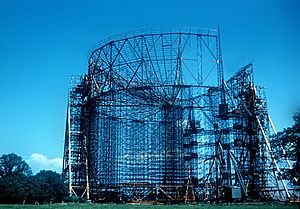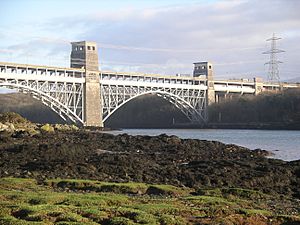Charles Husband facts for kids
Sir Henry Charles Husband (born October 30, 1908 – died October 7, 1983) was a very important British civil engineer. He was known for designing amazing bridges and other big engineering projects. He came from Sheffield, England.
Sir Henry is especially famous for his work on the Jodrell Bank radio telescopes. The first one, called the Lovell Telescope, was the biggest steerable radio telescope in the world when it was finished in 1957. He also helped design the huge antennas at Goonhilly Satellite Earth Station. Other cool projects included one of the first machines for treating cancer with radiation, Sri Lanka's tallest building, and rebuilding the famous Britannia Bridge after a fire. He received many top awards for his work, like the Royal Society's Royal Medal.
Contents
Early Life and School
Henry Charles Husband was born in Sheffield in 1908. His father, Joseph Husband, was also a civil engineer. Joseph even started the civil engineering department at Sheffield Technical School. Later, he became the first professor of civil engineering at the University of Sheffield.
Henry went to King Edward VII School in Sheffield. He then studied engineering at Sheffield University. He earned his engineering degree in 1929.
His Engineering Career
Henry Husband's first job was with the Barnsley Water Board. After that, he worked for another famous engineer, Sir Owen Williams, from 1931 to 1933. He then spent three years working on large housing projects across England and Scotland.
In 1936, Henry, his father Joseph, and Antony Clark started their own engineering company. It was first called Husband and Clark, but later became Husband & Co. The company was based in Sheffield. During World War II, Henry worked for the government on aircraft manufacturing. After the war, he led the company and helped it grow a lot. They worked for big clients like the British Iron and Steel Research Association.
Building Giant Radio Telescopes
Sir Henry Husband worked closely with Bernard Lovell. Lovell founded the Jodrell Bank Observatory in Cheshire. They teamed up to design and build the observatory's first huge steerable radio telescope. It was known as the "250-foot telescope" and is now called the Lovell Telescope.
After World War II, Lovell wanted a much bigger antenna to study cosmic rays. He imagined a giant steerable telescope. Other engineers thought this idea was "impossible" because it was such a huge challenge. But when Husband met Lovell in 1949, he said it "should be easy." He compared it to building a swing bridge over the River Thames!
Husband started drawing plans for the telescope in early 1950. He and Lovell decided on a dish that was 250 feet (76 meters) across. Construction began in 1952. Even with Husband's optimism, the project had many delays and cost more than expected. This was due to changes in Lovell's plans and rising steel prices. They even used wind-tunnel studies with a small model to help with the final design.
The telescope was finally finished in 1957. It was the largest fully steerable radio telescope in the world at that time. It is still working today! Lovell said they designed it using only a "desk calculator and slide rule." This led to a very strong structure with extra steel, which Lovell believed helped the telescope last so long. This telescope is now a special "grade-I-listed structure" in Britain. This means it is of "exceptional interest."
Husband also helped design the steerable radio antennas at the GPO's Goonhilly Satellite Earth Station in Cornwall. He also worked on other radio telescopes in the UK and other countries.
Other Cool Projects
Husband & Co. worked on many other exciting projects under Henry's leadership. In 1946, they designed a place to test jet engines at high altitudes. In the 1950s, Husband helped design one of the first telecobalt radiotherapy units. This machine was used for radiation treatment of cancer. It was installed at the Churchill Hospital in Oxford. Like the radio telescopes, this project involved moving a very heavy object (the radiation source) precisely in different directions.
He designed many bridges for roads and trains. Husband was chosen to rebuild the Britannia Bridge in Wales. This bridge crosses the Menai Strait. The original bridge, built by Robert Stephenson in 1850, was damaged by fire in 1970. Husband designed a double-deck bridge. It included a new road deck in addition to the train tracks. He said this was part of Stephenson's original idea. His company also designed the bridge used in the 1957 movie, The Bridge on the River Kwai.
Outside the UK, Husband & Co. had an office in Colombo, Sri Lanka. They worked on many projects there. Henry Husband designed the Ceylon Insurance Building in Colombo. This was a 16-story building with a helicopter landing pad on its roof. When it was finished in 1960, it was the tallest building in Sri Lanka, standing almost 55 meters high.
Awards and Honours
Henry Husband received many awards for his important work. He was given the CBE in 1964. In 1965, he won the Royal Medal from the Royal Society. This was for his "distinguished work in many aspects of engineering." It especially recognized his designs for large structures like the radio telescopes at Jodrell Bank and Goonhilly Downs. He was the first person to receive this medal for applied sciences.
He also won the Wilhelm Exner Medal in 1966. He received the Gold Medal of the Institution of Structural Engineers in 1973. Other awards included the Benjamin Baker Gold Medal (1959) and the James Watt medal (1976). Both of these were from the Institution of Civil Engineers. He was given special honorary degrees from the universities of Manchester (1964) and Sheffield (1967). He was made a knight in 1975, becoming Sir Henry Husband.
He was the president of the Institution of Structural Engineers from 1964 to 1965. He also led the Association of Consulting Engineers in 1967. He was a founding member of the Fellowship of Engineering.
Personal Life
In 1932, Henry Husband married Eileen Margaret Nowill. She was also from Sheffield and was an architect's daughter. They had four children. Their older son, Richard Husband, also became a civil engineer. Sir Henry retired in 1982. He passed away in 1983 in Nether Padley, near Sheffield.
See also
- Mott MacDonald, the company Husband & Co. joined in 1990




